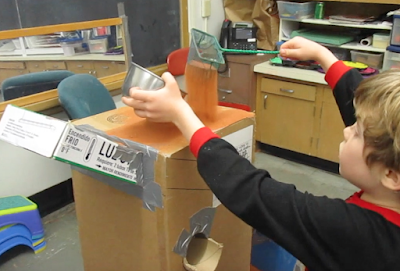Fire fighting from Thomas Bedard on Vimeo.
It is the child's enterprise to make sense of the world. Sometimes that is as simple as pouring and filling a container with sand. (Actually those operations are not as simple as they seem. See The Art of Pouring.) Sometimes the child brings a certain experience or prior knowledge to the operation of filling and pouring that adds a representational element to something observed in the world. I am not sure the child in this episode has seen a real life helicopter fighting a fire, but he could have easily seen one depicted in a book or video. By bringing his prior knowledge to his exploration at the sensory table, he is able to represent how such a helicopter works. There are several features to his actions which may be salient for him as he depicts the fire fighting helicopter, but one that stands out is how the "stuff" to put out the fires is dispersed; the minnow net offers a credible facsimile of the fire-fighting actions of such a helicopter. As of yet, he does not have the word disperse in his verbal repertoire, but he certainly does in his developing repertoire of physical and observational operations. Without a real or play helicopter in sight, I guess that is how a minnow net full of sand and a bowl over a tower apparatus becomes a fire fighting helicopter.This is a blog for early childhood teachers looking for ways to expand and enrich play and learning in and around their sand and water tables with easy-to-make, low-cost apparatus. It may also be of interest for anyone who appreciates children's messy play.
About Me

- Tom Bedard
- Early childhood education has been my life for over 40 years. I have taught all age groups from infants to 5-year-olds. I was a director for five years in the 1980s, but I returned to the classroom 22 years ago. My passion is watching the ways children explore and discover their world. In the classroom, everything starts with the reciprocal relationships between adults and children and between the children themselves. With that in mind, I plan and set up activities. But that is just the beginning. What actually happens is a flow that includes my efforts to invite, respond and support children's interface with those activities and with others in the room. Oh yeh, and along the way, the children change the activities to suit their own inventiveness and creativity. Now the processes become reciprocal with the children doing the inviting, responding and supporting. Young children are the best learners and teachers. I am truly fortunate to be a part of their journey.
Tuesday, November 10, 2020
Fire fighting helicopter
How does a minnow net full of sand and a bowl over a tower apparatus become a fire fighting helicopter in the hands of a child?
It begins with the child lifting the bowl and the minnow net over the top of the apparatus. Once over the top of the apparatus, the child lifts the minnow net full of sand out of the bowl. As he does that, he notices how the minnow net disperses the sand. Not only that, he sets the minnow net in motion as he covers the top of the appartus with the sand.
As the flow of sand dwindles, he scatters that last bit of sand back into the table.
At this point, he switches strategies. Instead of filling the minnow net with sand and placing it in the bowl so the sand stays in the net, he fills his bowl with sand and pours it into the net over the top of the apparatus. That way, he gets a more vigourous flow from the minnow net.
Again, as the flow dwindles from the minnow net, the child moves the final bit of sand over the side of the apparatus that has the cascade incline.
Below is the video of the episode. It clearly shows his focus on how the minnow net disperses the sand. As he scoops sand into his bowl for a second pour, he reveals that helicopters have something that they pour over fire.
Subscribe to:
Post Comments (Atom)





No comments:
Post a Comment